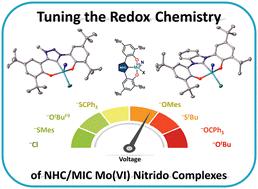当前位置:
X-MOL 学术
›
Dalton Trans.
›
论文详情
Our official English website, www.x-mol.net, welcomes your
feedback! (Note: you will need to create a separate account there.)
Synthesis and electrochemical properties of molybdenum nitrido complexes supported by redox-active NHC and MIC ligands
Dalton Transactions ( IF 3.5 ) Pub Date : 2024-11-01 , DOI: 10.1039/d4dt02405b Daniel Leitner, Florian R. Neururer, Stephan Hohloch
Dalton Transactions ( IF 3.5 ) Pub Date : 2024-11-01 , DOI: 10.1039/d4dt02405b Daniel Leitner, Florian R. Neururer, Stephan Hohloch

|
We report the synthesis of a series of molybdenum nitrido complexes supported by bis-phenolate N-heterocyclic and mesoionic carbenes (NHC & MIC). The reaction between MoN(OtBu)3 and the corresponding azolium salts [H3L1]Cl and [H3L2]Cl (with L1 = bis-phenolate triazolylidene and L2 = bis-phenolate benzimidazolylidene) gives clean access to the corresponding NHC/MIC complexes 1-Cl and 2-Cl. Electrochemical investigations of these complexes showed that they can be reversibly reduced at potentials of −1.13 and −1.01 V vs. Fc/[Fc]+ and the reduced complexes [1-Cl]− and [2-Cl]− can be cleanly isolated after chemical reduction with one equivalent of decamethylcobaltocene. Exchange of the halide atoms is furthermore reported to give a series of nitrido complexes supported by tert-butanolate (1-OtBu and 2-OtBu), perfluoro-tert-butanolate (1-OtBuF9 and 2-OtBuF9), tritylate (1-OCPh3 and 2-OCPh3), mesitolate (1-OMes and 2-OMes), thio-tert-butanolate (1-StBu), thiotritylate (1-SCPh3 and 2-SCPh3) and thiomesitolate complexes (1-SMes). The electrochemical properties of all complexes were evaluated and compared. All isolated complexes were characterized by multinuclear and multidimensional NMR spectroscopy and (if applicable) by EPR spectroscopy. Furthermore, the reactivity of 1-Cl and 2-Cl in the presence of protons and decamethylcobaltocene was investigated, which shows facile extrusion of ammonia, yielding diamagnetic bis-molybdenum(III) complexes 3 and 4.
中文翻译:

氧化还原活性 NHC 和 MIC 配体支持的氮钼配合物的合成和电化学性质
我们报道了由双酚酸酯N-杂环和中离子卡宾(NHC & MIC)支持的一系列钼硝基复合物的合成。MoN(OtBu)3 与相应的唑盐 [H3L1] Cl 和 [H3L2] Cl(L 1 = 双酚酸三氮基氮基和 L2 = 双酚酸苯并咪唑基)之间的反应可以清洁地获得相应的 NHC/MIC 络合物 1-Cl和 2-Cl。对这些配合物的电化学研究表明,它们可以在 -1.13 和 -1.01 V 对 Fc/[Fc]+ 的电位下进行可逆还原,并且还原的配合物 [1-Cl]− 和 [2-Cl]− 在用一种当量的十甲基钴烯进行化学还原后可以干净地分离。 此外,据报道,卤化物原子的交换会产生一系列由叔丁酸酯(1-OtBu 和 2-OtBu)、全氟叔丁酸酯(1-OtBuF9 和 2-OtBuF9)支持的亚硝基络合物)、三酯酸盐(1-OCPh3 和 2-OCPh3)、间二酯(1-OMes 和 2-OMes)、硫代叔丁酸酯 (1-StBu)、硫代丁酸酯(1-SCPh3 和 2-SCPh3)和硫氨酸酯络合物(1-SMes).评价和比较了所有复合物的电化学性质。所有分离的复合物都通过多核和多维 NMR 波谱和 (如果适用) EPR 波谱进行表征。此外,研究了 1-Cl 和 2-Cl 在质子和十甲基钴烯存在下的反应性,这表明氨易于挤压,产生抗磁性双钼 (III) 络合物 3 和 4。
更新日期:2024-11-01
中文翻译:

氧化还原活性 NHC 和 MIC 配体支持的氮钼配合物的合成和电化学性质
我们报道了由双酚酸酯N-杂环和中离子卡宾(NHC & MIC)支持的一系列钼硝基复合物的合成。MoN(OtBu)3 与相应的唑盐 [H3L1] Cl 和 [H3L2] Cl(L 1 = 双酚酸三氮基氮基和 L2 = 双酚酸苯并咪唑基)之间的反应可以清洁地获得相应的 NHC/MIC 络合物 1-Cl和 2-Cl。对这些配合物的电化学研究表明,它们可以在 -1.13 和 -1.01 V 对 Fc/[Fc]+ 的电位下进行可逆还原,并且还原的配合物 [1-Cl]− 和 [2-Cl]− 在用一种当量的十甲基钴烯进行化学还原后可以干净地分离。 此外,据报道,卤化物原子的交换会产生一系列由叔丁酸酯(1-OtBu 和 2-OtBu)、全氟叔丁酸酯(1-OtBuF9 和 2-OtBuF9)支持的亚硝基络合物)、三酯酸盐(1-OCPh3 和 2-OCPh3)、间二酯(1-OMes 和 2-OMes)、硫代叔丁酸酯 (1-StBu)、硫代丁酸酯(1-SCPh3 和 2-SCPh3)和硫氨酸酯络合物(1-SMes).评价和比较了所有复合物的电化学性质。所有分离的复合物都通过多核和多维 NMR 波谱和 (如果适用) EPR 波谱进行表征。此外,研究了 1-Cl 和 2-Cl 在质子和十甲基钴烯存在下的反应性,这表明氨易于挤压,产生抗磁性双钼 (III) 络合物 3 和 4。


















































 京公网安备 11010802027423号
京公网安备 11010802027423号